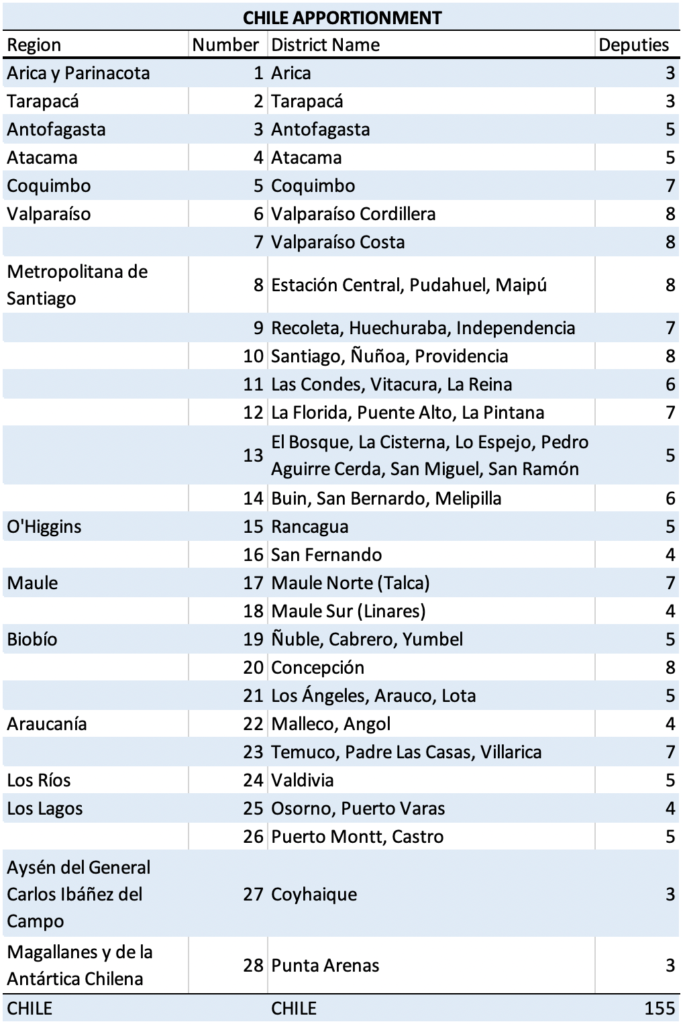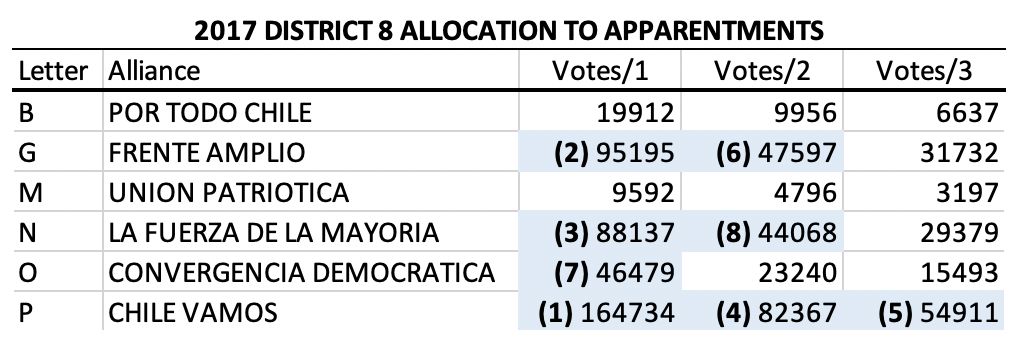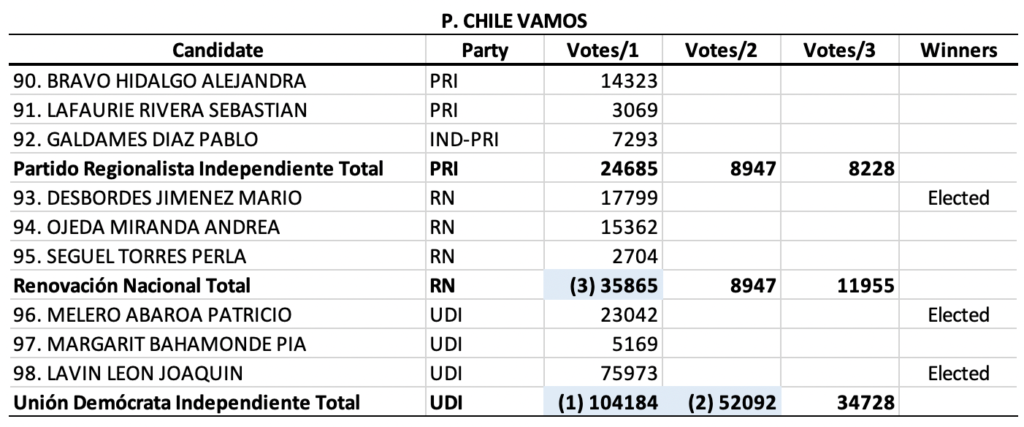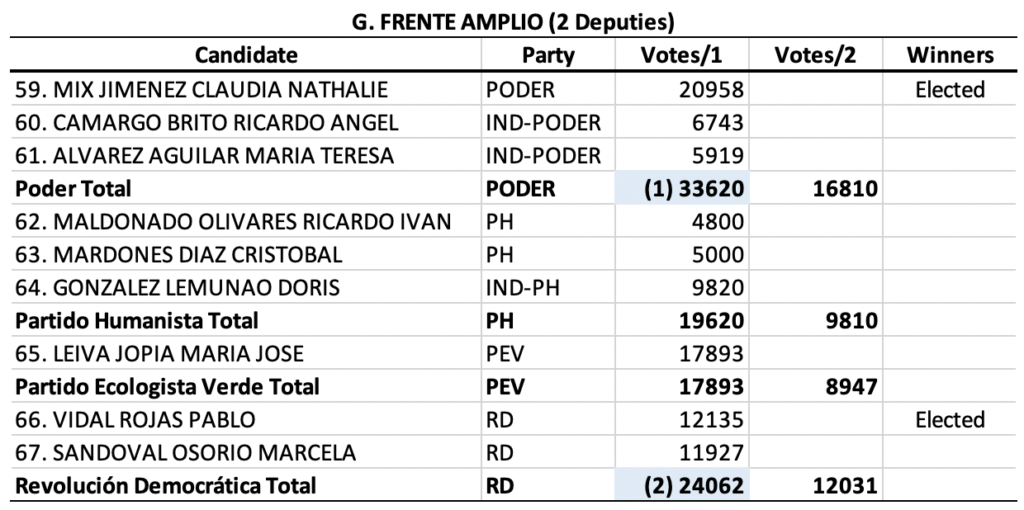CHILE 1 (1989-2013)
Chile referred to its electoral system for the Chamber of Deputies as the binomial system, which is equivalent to the d’Hondt system of proportional representation with open lists applied within 2-member districts. Each party or coalition could run only up to two candidates within each constituency.
Voters cast a ballot for a single candidate with seats allocated based on the total votes won by a party or coalition’s two candidates. The small district magnitude resulted in the first and second place party or coalition each winning one seat unless the first-place party or coalition gained at least twice as many votes as the second-place party or coalition. If a party or coalition gained only one seat, then the candidate with more votes received the seat.
The high barrier to winning a seat and the need to double the second-place party’s votes to gain both seats encouraged parties to form alliances and forced negotiations among them about which party ran candidates in which constituencies.
The following table shows the results from District 1 in 2013. The Nueva Mayoría coalition came in first but its share of the vote was not double that of second-place Si Tú Quiere, Chile Cambia coalition, so it received only one seat. The seat went to the Partido Socialista de Chile as its candidate received more votes than the Partido por la Democracia candidate. The Partido Liberal de Chile gained the second seat, as the leading party in the second-place coalition.
 The next table shows the 2013 results in District 6. In this constituency, Nueva Mayoría received more than twice as many votes as the second-place Si Tú Quiere, Chile Cambia coalition, so it gained both seats (i.e. seats were won by both the Partido Demócrata Cristiano and the Partido Radical Socialdemócrata).
The next table shows the 2013 results in District 6. In this constituency, Nueva Mayoría received more than twice as many votes as the second-place Si Tú Quiere, Chile Cambia coalition, so it gained both seats (i.e. seats were won by both the Partido Demócrata Cristiano and the Partido Radical Socialdemócrata).
CHILE 2 (2017-)
In 2017, enlarged the size of its parliament to 155 members. A capsule summary of the new system is that seats are allocated using the D’Hondt system first to apparentments and then to parties within 28 constituencies ranging in size from three to eight deputies. The candidates with the most votes on a party’s list receive their party’s seats. The remainder of this section provides a more detailed description.
Deputies are now elected from 28 districts that each elect between three and eight deputies. The new district lines are fixed by law. Reviews of the number of seats allotted to each district are to occur every ten years but no district may receive fewer than three or more than eight deputies.
Here is the apportionment of seats:

Parties can form apparentments, electoral alliances, at the national level (i.e. parties must form the same alliance across all districts). Subapparentments, or alliances within the broader alliance, are prohibited. Parties may run up to one more candidate than there are seats to fill in a district.
Voters must cast their ballot for a single parliamentary candidate. A party’s vote total equals all of the votes cast for its candidates. Similarly, an electoral alliance’s, or apparentment’s, vote total equals the sum of the vote totals for all parties participating in the alliance.
Chile allocates seats first to alliances using the D’Hondt system of proportional representation. Next, it also utilizes the D’Hondt system to distribute seats to parties within an alliance. Finally, any seats won by a party go to the candidates with the most votes.
Here is an example of how the allocation process worked from Electoral Constituency 8, one of the districts located in Metropolitan Santiago. The following table shows the number of votes won by each apparentment and the distribution according to the D’Hondt formula.

Seats were distributed to apparentments in descending order of their D’Hondt quotas. The D’Hondt quota for each party equals the number of votes received divided by the number of seats held plus 1 with the quota recalculated each time it gains a seat. The boldface numbers to the left of the D’Hondt quotas show the allocation order.
Next, seats had to be awarded to parties within alliances. The following table presents the process of allocating the three seats won by the Chile Vamos apparentment to parties within the alliance and then to candidates. Parties within the apparentment gain seats in descending order of their D’Hondt quotas based on the total number of votes won by each party.

As the table reveals UDI won the first seat because it had the most votes. It also gained the second seat as its second D’Hondt quota (i.e. votes/2) was still higher than the total votes (i.e. first D’Hondt quota) received by either of the other two parties. However, UDI’s third D’Hondt quota (i.e. votes/3) fell short of RN’s first quota, so RN snapped up the last seat.
Patricio Melero Abaroa and Joaquin Lavin León won the two UDI seats as they had more votes than the third UDI candidate. Similarly, Mario Desbordes Jiménez won the RN seat as he won the most votes of any of RN’s candidates.
Here is the same process for the Frente Amplio apparentment:

Frente Amplio garnered only two deputies; the first went to PODER and the second to RD. As the highest vote earners of their parties, Claudia Nathalie Mix Jiménez and Pablo Vidal Rojas became deputies. While Mix Jiménez won more votes than any other candidate, note that Vidal Rojas gained a seat even though he won fewer votes than the PEV candidate.
Sources: Servicio Electoral de Chile; Ricardo Gamboa and Mauricio Morales, “Chile’s 2015 Electoral Reform: Changing the Rules of the Game,” Latin American Politics and Society 58(2016): 4(Winter), 126-44.

